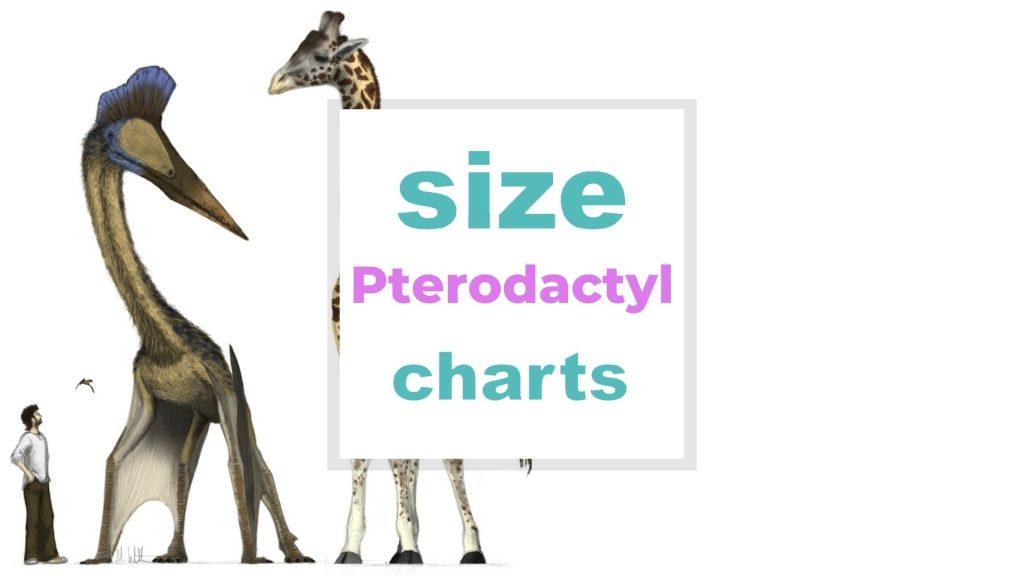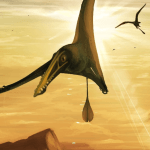Pterodactyl Size
One of the most magnificent prehistoric creatures that lived millions of years ago, the Pterodactyl, did not lurk on the ground but instead soared overhead- the pterodactyl (skip straight to the pterodactyl size chart).
Pterodactyls were one of the largest flying animals that ever lived, with some species having wingspans of over 10 meters (33 feet). Despite their size, pterodactyls were relatively lightweight, thanks to their hollow bones and air-filled regions in their bodies.

Pterodactyls had long, screen-like membranes that stretched from the tips of their fingers all the way to the base of their tails. These membranes served as wings and allowed pterodactyls to glide through the air with ease. Pterodactyls also had sharp beaks and teeth, which they used to catch fish and other small animals. Thanks to their size and flying ability, pterodactyls were the top predators in their ecosystem.
The glorious fliers existed from the late Triassic era to the end of the Cretaceous period (230 million—65 million years ago).
Jump right into the Frequently Asked Questions
Related: Halter Size chart – a complete sizing and fitting guide, Horse Size Charts: the complete overview
Pterodactyl Size Table of Contents
- Pterodactyl size
- What size is the largest Pterodactyl?
- How tall is a Pterodactyl?
- Frequently Asked Questions
Pterodactyl size
Related: Blue Whale Size and Dimensions
Pterodactyl size across the world is estimated with a wingspan of around 40 feet stretched over bones, and an unusually long neck nearly three meters in length. Hoisted on the ground, it can get as tall as a giraffe and is no doubt a part of the splendid history of our planet.
Pterodactyl type sizes chart
| Type | Weight (kg) | Lbs | Length of wingspan (metres) | feet | Length (metres) | feet |
| Eudimorphodon | 10 | 22 | 1 | 3.3 | 1.8 | 6 |
| pterodactylus | 0.8 – 4 | 2-10 | 2-11 | 6.5 – 36 | 1.05 | 3.5 |
| dimorphodon | 2 | 4.4 | 1.38 | 4.6 | 1 | 3.3 |
| Rhamphorhynchus | 25 | 55 | 1.81 | 5.9 | 1.26 | 4.1 |
| tapejara | 0.42 | 0.9 | 1.4 | 4.62 | 0.23 | 0.76 |
| nyctosaurus | 1.86 | 4.1 | 2 | 6.6 | 0.5 | 1.65 |
| dsungaripterus | 13.6 | 30 | 3 | 9.8 | 1.2 | 4 |
| zhejiangopterus | 7.9 | 17 | 3.5 | 11.5 | 1.2 | 4 |
| Zhenyuanlong | 20 | 44 | 3.3 – 3.9 | 11 – 13 | 2 | 6.6 |
| anhanguera | 23 | 50.6 | 4.6 | 16 | 1.2 | 4 |
| Thalassodromeus | 30 | 66 | 4.2 – 4.5 | 14-15 | 1.42 | 4.8 |
| pteranodon | 50 | 110 | 5.5 | 19 | 2 | 6.5 |
| Quetzalcoatlus | 200 – 250 | 440 – 550 | 10 – 12 | 36 – 40 | 5-6 | 18-20 |
| pterodaustro | 1.4 | 3 | 2.4 | 8.2 | 1.2 | 4 |
| peteinosaurus | 10 | 22 | 0.6 | 2 | 1.2 | 4 |
When it comes to grouping the pterosaurs, you may find diverse genera, including Pteranodon and Pterodactyl-generally jumbled. Pteranodons were likely to be larger, leathery-winged whereas the Pterodactylus was categorized as a smaller species, close to the size of eagles or hawks, and eventually evolved into the birds found today.
What size is the largest Pterodactyl?
Related: Cat Size Chart and Why It Is Important?
The largest Pterodactyl size is debated by scientists, but the most agreed-upon estimate is that they reached a wingspan of 40 feet (480 inches or 12 meters). Some argue that they could have reached up to 50 or even 60 feet (720 inches or 19 meters), but there is no concrete evidence for this.
Despite their large size, pterodactyls were incredibly lightweight creatures with hollow bones filled with air sacs. This made them excellent fliers, and they are thought to have been able to reach speeds of up to 50 mph in short bursts!
Important to note also that the average length of a Pterodactyl is 3.5 feet (42 inches or 1 meter). They are actually considered to be the largest flying animal ever to have ever lived. According to Professor Steve Brusatte, Chair of paleontology at Edinburgh University, they found and preserved a wonderful fossil skeleton belonging to a new species of pterosaurs in Scotland, which serves to bring out some of this information.
It was big enough, much bigger than a late Jurassic-aged pterosaur- measured as the size of a modern-day albatross, currently the largest flying bird.
Check out this video to learn more about pterodactyl size
How tall is a Pterodactyl?
Related: Dog Kennel Size Chart: Find the right sized Kennel for your dog breed, Maine Coon Size Chart by age and compared to other cat breeds
There is debate on how tall pterodactyls were, as no one has seen one alive in modern times. Based on fossil evidence though, scientists believe that they could range anywhere from 3 to 10 feet tall (12 inches or 3 meters), twice as large as that of an albatross-the gigantic flying creature with the longest wingspan.
The exception to this size range is the Colossal Cloud Cruiser pterodactyl, which was estimated to be up to 36 feet tall! To put that into perspective, that’s nearly as tall as a school bus! Imagine seeing one of those flying around!
Frequently Asked Questions
What is the size and weight of a Pterodactyl?
The average size of these reptiles is around a 3-meter long head (118 inches), a 3-meter stretched neck, limbs as long as 2.5 meters (98 inches), and a torso the size of about 2 meters.
The largest pterosaurs ever found are estimated to have weighed nearly 250 kilograms (550 lb.). Whereas the smallest size Pterodactyl was measured as small as a sparrow.
How big are pterodactyls compared to humans?
In comparing Pterodactyl size vs humans, the average human is only about 6 feet tall, making pterodactyls several times larger than the average person. While pterodactyls were not as big as some of the largest land animals, such as dinosaurs, their size was still impressive.
In fact, pterodactyls were so large that they would have dwarfed even the biggest birds of today. So next time you see a bird flying overhead, just imagine how much bigger it would be if it was a pterodactyl!
Can pterodactyls carry a human?
Some experts believe that it is possible that small pterodactyls may have been able to carry very small humans, such as infants or children. Nevertheless, this remains purely speculative and there is no concrete evidence to support this claim.
Once they take off they need to flap their wings to get to a higher altitude. If they carry some extra load on their back, they would not be able to glide higher for lengthier.
Are pterodactyls still alive?
The most common theory is that pterodactyls went extinct 65 million years ago, along with the dinosaurs. However, there have been occasional sightings of winged creatures that could possibly be pterodactyls. In addition, some scientists believe that pterodactyls may have evolved into modern-day birds.
According to Matt Cartmill, professor of evolutionary anthropology at Duke University, it is extremely unlikely to find living pterodactyls in the modern world.
How fast can a Pterodactyl run?
Based on its size and weight, as well as its wing shape and musculature, experts estimate that it could reach speeds of up to 60 miles per hour. That would make it one of the fastest-flying animals of all time.
And given that it could also take off from a standing start, it would have been able to pursue prey with remarkable agility and speed. So if you were ever unfortunate enough to cross paths with a Pterodactyl, you would definitely want to make a run!
A study published in the journal PLOS ONE states that Pterodactyl had influential flight powers that assist them to walk as quadrupeds (four-footed) like vaults and bats into the air. Once they fly, they could touch a speed over 67 mph(108 kph) for a few minutes and then slide at a cruising speed of around 56 mph (90 kph).
Moreover, the fossil investigation has shown certain genera of this massive creature underwent a series of transformations, and Pterodactyl size across a period varied and eventually was driven into extinction. Fewer species could survive and hence evolved into birds found in today’s world.
Conclusion
It is amazing to think about the size of some dinosaurs, and even more impressive when you consider that there are still creatures alive on Earth today that dwarf those ancient animals.
The Pterodactyl is a perfect example; this airborne reptile was once thought to be one of the largest animals to ever live, with wingspans up to 30 feet (360 inches or 9 meters)! While they are not as large as they once were – likely due to competition from bats – these creatures must have been an awe-inspiring sight.
Got any questions or fun facts to contribute? You are most welcome to ask your questions in the comments or add any interesting Pterodactyl size facts.
Picture in this post is from Newsweek.com
Related to Pterodactyl Size
- Toy Poodle Size Chart by Age : How big will a Toy Poodle get?
- Cat Size Chart and Why It Is Important?
- Pterodactyl Size
- Blue Whale Size and Dimensions
- Dog House Size Chart by breed
- Dog Bed Sizing Guide – Choosing the Right Bed Size for Your Dog
- Dog Turtleneck Size Chart – The Ultimate Guide
- Dog Raincoat Size Chart – How to find out the best size for your dog
- Dog Kennel Size Chart: Find the right sized Kennel for your dog breed
- Dog Vest Size Chart
- Baskerville Muzzle Size
- Horse Saddle Size chart – Find your English or Western Saddle Size
- Horse Bridle Size chart
- Halter Size chart – a complete sizing and fitting guide
- Horse Blanket Size Chart and Fitting Guide
- Dog Hoodie Size Chart
- Dog T-Shirt Size Chart – The Ultimate Guide


















